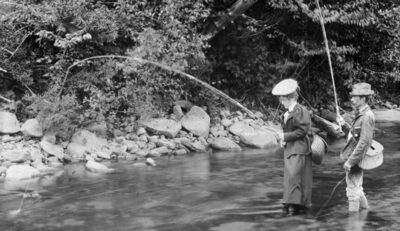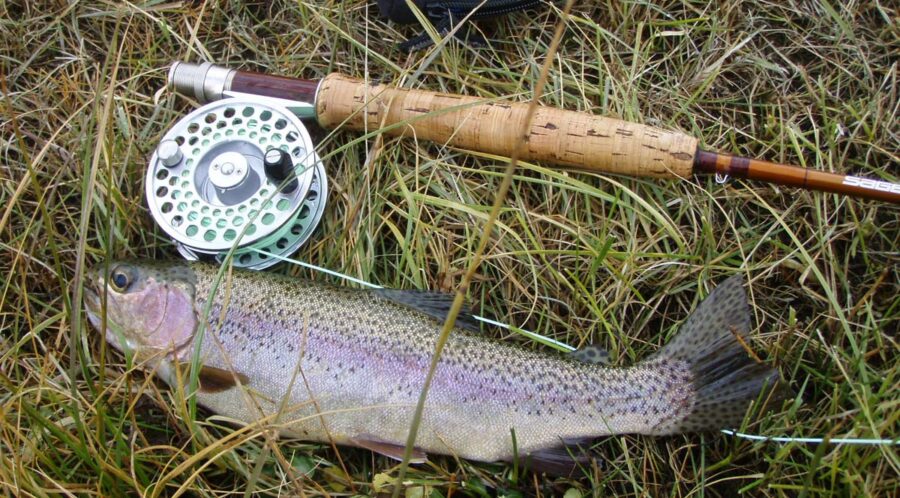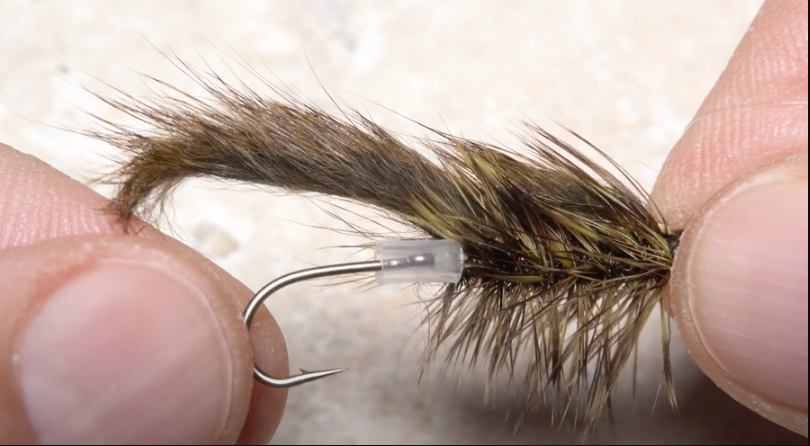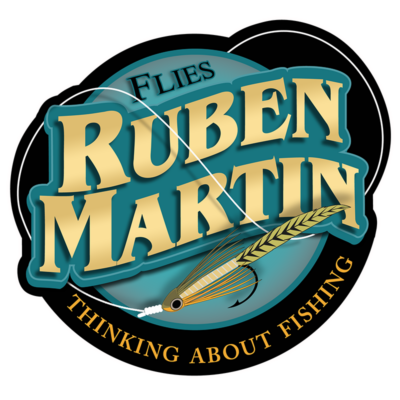
Henry Clement
The fly stays in the box because it still produces
By Henry Clement
A few weeks ago, summer vacations had shrunk our tying group to Angie, Carla, and me. TJ Douglas was in town, so he joined us in the evening before heading home to Wyoming the following day.
The conversation at dinner focused on a posting I’d planned. It was to be a list of trout flies that remained popular and why.
Never shy of a story about flies, TJ chipped in during coffee. He had read a story by Paul Schullery, author of several books about fly fishing, the American West, and conservation.

Catskills fly fishing in the 1800s. Flies were mostly tied by women, who were called fly dressers. This is a Wikimedia Commons image.
Torn and tattered
The Mystery of the Ratty Fly, written by Paul Schullery, was picked up by Midcurrent in 2011. TJ said the story was about beat-up flies that turned out better because, according to the author, they were ratty. Ratty flies had lost their dress for the school dance look, chewed on, and then triggered an eat.
We all had the experience of catching Mo Betta with ‘ratty’ flys
Angie and Carla pooh-poohed the idea of publishing yet another ‘best’ flies list, saying there were already enough best trout flies lists that if they were all printed, they’d be enough books about the subject that Marcel Proust’s seven-volume masterpiece In Search of Lost Time would appear puny next to it.
“Besides,” Angie added, “the best of anything ‘lists’ always require decem or its number equivalent, also in Latin, X. We have all seen these ten-of-lists. Everything from ’10’ of the best tasting condoms to ’10’ of the best doomsday plans to ’10’ of the most comfortable prisons, and so on.”
Then, there’s the chooser
TJ jumped in. “There are not only hundreds of variables within the ranking of trout flies, but what about the ‘rankers’ themselves—more subject variances? Both would require an uncountable number of variants impacting that list and any list. There is no need to ‘list’ them; you get the point.”

Paul Schullery is the author, co-author, or editor of more than a dozen books about Yellowstone National Park. He has been the recipient of a number of prestigious literary and professional awards, including honorary doctorates from Montana State University and Ohio University; the Wallace Stegner Award from the University of Colorado Center of the American West; and the Roderick Haig-Brown Award from the Federation of Fly Fishers. He has spoken on conservation issues in the national media, including the Today Show, PBS, World Monitor News, the History Channel, and NPR. He wrote and narrated the award-winning 2002 PBS/ABC feature film Yellowstone: America’s Sacred Wilderness. He served on the advisory board for the Ken Burns 2009 PBS series The National Parks: America’s Best Idea and appeared frequently in the film. Since 2009, he has served as Scholar in Residence at the Montana State University Library in Bozeman, Montana.
The author speaks
“———- I was fishing a small, undistinguished local trout stream, and as I released one of its small, undistinguished local trout, I noticed that the hackle on my Adams had unwound and was trailing loose. But when I reached for my fly box to replace the ruined fly, I found myself wondering: Did the fish I was releasing tear that hackle loose, or was the loose hackle the reason the fish took the fly? The trout wouldn’t tell me, of course, and rather than launch what I knew would be a quixotic attempt at empirical study by continuing to fish with the damaged fly, I put on a new one.
But the experience got me thinking about one of angling folklore’s most intriguing and persistent minor narratives. Spend a little time out on the shadowy margins of fly-fishing propriety, and you’re sure to encounter the tale of the ratty fly. Many fishermen remember a day when they were using a fly the fish loved so much that they gradually chewed it to pieces. And still, the fish took it.” —- Paul Schullery
Food ‘not’ for thought. A Fly for All Seasons
Then there are the puzzling fly patterns that have no parents. An example of one such fly that has universal appeal to ‘trouts’ from any coordinate. You know it well. It is Richard Blessing’s supposed Dobson fly that was born disfigured and called the Woolly Bugger.
That fly, the bugger, has in all its iterations, and even when an infirmary visit was needed, it still got eaten by snook, trout, basses, tarpon, and panfish. On one occasion, my tube fly bugger had some flash break off and dangle – partially unraveled. I could see it flopping in the water, and I retrieved it with no intention other than getting it in to change it out. Whammo, a brown, took it 10-feet from the gunnel.

Typical Firehole River rainbow trout (released) October 2007. Photo by Mike Cline.
After releasing the best fish of the day, I snipped off the straggler flash and put the bugger back in play
” The wise Canadian angling writer Roderick Haig-Brown deserves the last word on the mysteries of rattiness. In Fisherman’s Spring (1951), Haig-Brown said that the experience of catching fish on such ‘tattered and torn’ flies was universal among anglers, but he took the experience another step.” –— Paul Schullery








